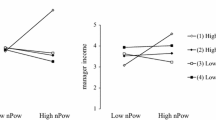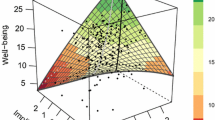Abstract
This study investigates explicit –implicit motive discrepancies and their effect on well-being. Participants were 382 executive managers (107 females and 275 males). Female managers had higher explicit affiliation scores than males, whereas male managers had marginally significant higher explicit power scores than females. Males and females did not differ in their implicit motives. We expected a directional discrepancy on the power motive (explicit vs. implicit: “Striving for goals without gaining pleasure from doing so”) to predict impaired well-being. Results were consistent with this hypothesis, using polynomial regression analysis with response surface methods, instead of calculating motive difference scores. Discrepancies in the achievement and affiliation motives were not related to well-being. Results are discussed considering the specificity of motive discrepancies for selected groups, such as managers, and the importance of distinguishing between absolute versus directional motive discrepancy scores in motivation research.



Similar content being viewed by others
Notes
Edwards (personal communication) does not recommend standardizing the predictors based on the sample data. He affirms that “the scales cannot be made equivalent by standardizing them, because the standardized scores do not indicate the position of the component variables relative to one another.” We believe, however, that standardizing both predictors according to the norms of the population, if they are available, overcomes this problem. Edwards recommends to measure each predictor from the beginning using the same scale (e.g., a scale ranging from 1 to 7) and then to center each predictor using the midpoint of their common scale (i.e., 4). What can one do if the predictors are not measured using the same scale? One could convert the values of one predictor into the metric of the second. Harris et al. (2008), for example, did that by recoding actual salary range in dollars (first predictor) into 1–8, the values of the scale they used to measure upward comparison (second predictor), and then centered by subtracting from each predictor the common midpoint (4.5). This procedure, however, has the disadvantage that results in data reduction.
Readers interested in applying Polynomial Regression Analysis with Response Surface Methods as an alternative to difference scores are referred to the article of Linda Shanock et al. (2010). These authors not only explain the method in an understandable manner but also include a SPSS-Syntax showing how to carry out the polynomial regression analysis. Moreover, the paper is accompanied by an Excel spreadsheet, with which one can obtain the four surface values (a1 to a4) and the corresponding 3-dimensional response surface graphic, based on the results of the polynomial regression analysis. Instructions for downloading the Excel spreadsheet are given in the paper of Shanock et al. (2010).
After this article was accepted for publication we became aware of a paper by Gröpel (2008), confirming that explicit/implicit discrepancies in the power motive but not on achievement or affiliation predicted well-being in a sample of managers. This author calculated partial correlations between motive discrepancies and well-being, controlling for action orientation.
References
Aiken, L. S., & West, S. G. (1991). Multiple regression: Testing and interpreting interactions. Newbury Park, CA: Sage.
Baumann, N., Kaschel, R., & Kuhl, J. (2005). Striving for unwanted goals: Stress-dependent discrepancies between explicit and implicit achievement motives reduce subjective well-being and increase psychosomatic symptoms. Journal of Personality and Social Psychology, 89, 781–799.
Baumann, N., Kazén, M., & Kuhl, J. (2010). Implicit motives: A look from personality systems interaction theory. In O. C. Schultheiss & J. C. Brunstein (Eds.), Implicit motives (pp. 375–403). New York, NY: Oxford University Press.
Brunstein, J. C. (2010). Implicit motives and explicit goals: The role of motivational congruence in emotional well-being. In O. C. Schultheiss & J. C. Brunstein (Eds.), Implicit motives (pp. 347–374). New York, NY: Oxford University Press.
Brunstein, J. C., & Maier, G. W. (2005). Implicit and self-attributed motives to achieve: Two separate but interacting needs. Journal of Personality and Social Psychology, 89, 205–222.
Brunstein, J. C., Schultheiss, O. C., & Grässmann, R. (1998). Personal goals and emotional well-being: The moderating role of motive dispositions. Journal of Personality and Social Psychology, 75, 494–508.
Cafri, G., van den Berg, P., & Brannick, M. T. (2010). What have the difference scores not been telling us? A critique of the use of self–ideal discrepancy in the assessment of body image and evaluation of an alternative data-analytic framework. Assessment, 17, 361–376.
Cohen, J., Cohen, P., West, S. G., & Aiken, L. S. (2003). Applied multiple regression/-correlation analysis for the behavioral sciences (3rd ed.). Mahwah. NJ: Erlbaum.
Cronbach, L. J., & Furby, L. (1970). How should we measure ‘change’—or should we? Psychological Bulletin, 74, 68–80.
Deci, E. L., & Ryan, R. M. (2000). The “what” and “why” of goal pursuits: Human needs and the self-determination perspective. Psychological Inquiry, 11, 227–268.
Donley, R. E., & Winter, D. G. (1970). Measuring the motives of public officials at a distance: An exploratory study of American presidents. Behavioral Sciences, 15, 227–236.
Edwards, J. R. (1994). The study of congruence in organizational behaviour research: Critique and a proposed alternative. Organizational Behavior and Human Decision Processes, 58, 51–100.
Edwards, J. R. (2001). Ten difference score myths. Organizational Research Methods, 4, 265–287.
Edwards, J. R. (2002). Alternatives to difference scores: Polynomial regression analysis and response surface methodology. In F. Drasgow & N. W. Schmitt (Eds.), Advances in measurement and data analysis (pp. 350–400). San Francisco: Jossey-Bass.
Emmons, R. A. (1991). Personal strivings, daily life events, and psychological and physical well-being. Journal of Personality, 59(3), 453–472.
Gröpel, P. (2008). Affect regulation and motive-incongruent goal orientations: Relationships to well-being. Studia Psychologica, 50, 137–146.
Harris, M. M., Anseel, F., & Lievens, F. (2008). Keeping up with the Joneses: A field study of the relationships among upward, lateral, and downward comparisons and pay level satisfaction. Journal of Applied Psychology, 93, 665–673.
Hofer, J., & Chasiotis, A. (2003). Congruence of life goals and implicit motives as predictors of life satisfaction: Cross-cultural implications of a study of Zambian male adolescents. Motivation and Emotion, 27, 251–272.
Kazén, M., & Kuhl, J. (2005). Intention memory and achievement motivation: Volitional facilitation and inhibition as a function of affective contents of need-related stimuli. Journal of Personality and Social Psychology, 89, 426–448.
Kehr, H. M. (2004). Implicit/explicit motive discrepancies and volitional depletion among managers. Personality and Social Psychology Bulletin, 30, 315–327.
Kuhl, J., & Henseler, W. (2004). Entwicklungsorientiertes Scanning (EOS) [Development-oriented Scanning (EOS)]. In L. von Rosenstiel & J. Erpenbeck (Hrsg.), Handbuch der Kompetenzmessung (S. 428–453). Heidelberg: Spektrum Akademischer Ver-lag.
Kuhl, J., & Kazén, M. (2008). Motivation, affect, and hemispheric asymmetry: Power versus affiliation. Journal of Personality and Social Psychology, 95, 456–469.
Kuhl, J., Kazén, M., & Koole, S. L. (2006). Putting self-regulation theory into practice: A user’s manual. Applied Psychology: An International Review, 55, 408–418.
Kuhl, J., & Scheffer, D. (2002). The operant motive test: Scoring manual. Germany: University of Osnabrück.
Kuhl, J., Scheffer, D. & Eichstaedt, J. (2003). Der Operante Motiv-Test (OMT): Ein neuer Ansatz zur Messung impliziter Motive [The operant motive test (OMT): A new approach to measure implicit motives]. In F. Rheinberg & J. Stiensmeier-Pelster (Hrsg.), Diagnostik von Motivation und Selbstkonzept (S. 129–149). Göttingen: Hogrefe.
Langens, T., & McClelland, D. C. (1997, August). Implicit motives, explicit motives, and emotional well-being. Poster presented at the 105th Convention of the American Psychological Association, Chicago.
Langer, E. (1975). The illusion of control. Journal of Personality and Social Psychology, 32, 311–328.
McClelland, D. C. (1985). Human motivation. Glenview, IL: Scott, Foresman & Co.
McClelland, D. C., Koestner, R., & Weinberger, J. (1989). How do self-attributed and implicit motives differ? Psychological Review, 96, 690–702.
Mouratidis, A., Vansteenkiste, M., Lens, W., & Auweele, Y. V. (2009). Beyond positive and negative affect: Achievement goals and discrete emotions in the elementary physical education classroom. Psychology of Sport and Exercise, 10, 336–343.
Scheffer, D. (2005). Implizite motive. Göttingen: Hogrefe.
Scheffer, D., Eichstaedt, J., Chasiotis, A., & Kuhl, J. (2007). Towards an integrated measure of need affiliation and agreeableness derived from the Operant Motive Test. Psychology Science Quarterly, 49, 308–324.
Schüler, J., Job, V., Fröhlich, S. M., & Brandstätter, V. (2008). A high implicit affiliation motive does not always make you happy: A corresponding explicit motive and corresponding behavior are further needed. Motivation and Emotion, 32, 231–242.
Schultheiss, O. C. (2008). Implicit motives. In O. P. John, R. W. Robins, & L. A. Pervin (Eds.), Handbook of personality: Theory and research (3rd ed., pp. 603–633). New York: Guilford.
Shanock, L. R., Baran, B. E., Gentry, W. A., Pattison, S. C., & Heggestad, E. D. (2010). Polynomial regression with response surface analysis: A powerful approach for examining moderation and overcoming limitations of difference scores. Journal of Business and Psychology, 25, 543–554. doi:10.1007/s10869-010-9183-4.
Sheldon, K. M., & Elliot, A. J. (1998). Not all personal goals are “personal”: Comparing autonomous and controlling goals on effort and attainment. Personality and Social Psychology Bulletin, 24, 546–557.
Sheldon, K. M., & Elliot, A. J. (1999). Goal striving, need satisfaction, and longitudinal well-being: The self-concordance model. Journal of Personality and Social Psychology, 76, 546–557.
Sheldon, K. M., & Kasser, T. (1995). Coherence and congruence: Two aspects of personality integration. Journal of Personality and Social Psychology, 68, 531–543.
Taylor, S. E., & Brown, J. (1994). Positive illusions and well-being revisited: Separating fact from fiction. Psychological Bulletin, 116, 21–27.
Thrash, T. M., Cassidy, S. E., Maruskin, L. A., & Elliot, A. J. (2010). Factors that influence the relation between implicit and explicit motives: A general implicit-explicit congruence framework. In O. C. Schultheiss & J. C. Brunstein (Eds.), Implicit motives (pp. 308–346). New York, NY: Oxford University Press.
Thrash, T., & Elliot, A. J. (2002). Implicit and self-attributed achievement motives: Concordance and predictive validity. Journal of Personality, 70, 729–756.
Thrash, T. M., Elliot, A. J., & Schultheiss, O. C. (2007). Methodological and dispositional predictors of congruence between implicit and explicit need for achievement. Personality and Social Psychology Bulletin, 33, 961–974.
Veroff, J., Reuman, D., & Feld, S. (1984). Motives in American men and women across the adult life span. Developmental Psychology, 20(6), 1142–1158.
Winter, D. G. (1988). The power motive in women–and men. Journal of Personality and Social Psychology, 54, 510–519.
Winter, D. G. (1991). A motivational model of leadership: Predicting long-term management success from TAT measures of power motivation and responsibility. The Leadership Quarterly, 2, 67–80.
Winter D. G. (2001). Measuring Bush’s motives. Proceedings of the international society for political psychology. ISPP News, 8–9.
Acknowledgments
We thank Linda Shanock for her useful methodological advice. Jeff Edwards helped us in clarifying some methodological issues related to polynomial regression. Finally, we are also thankful to Frank Pundsack for his feedback on portions of the manuscript and his valuable help in the preparation of the response surface graphics.
Author information
Authors and Affiliations
Corresponding authors
Rights and permissions
About this article
Cite this article
Kazén, M., Kuhl, J. Directional discrepancy between implicit and explicit power motives is related to well-being among managers. Motiv Emot 35, 317–327 (2011). https://doi.org/10.1007/s11031-011-9219-8
Published:
Issue Date:
DOI: https://doi.org/10.1007/s11031-011-9219-8




